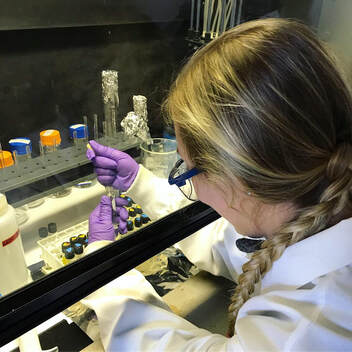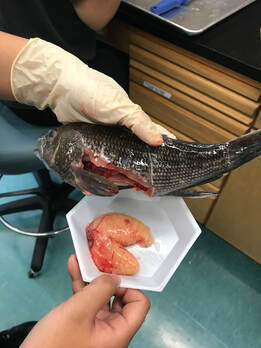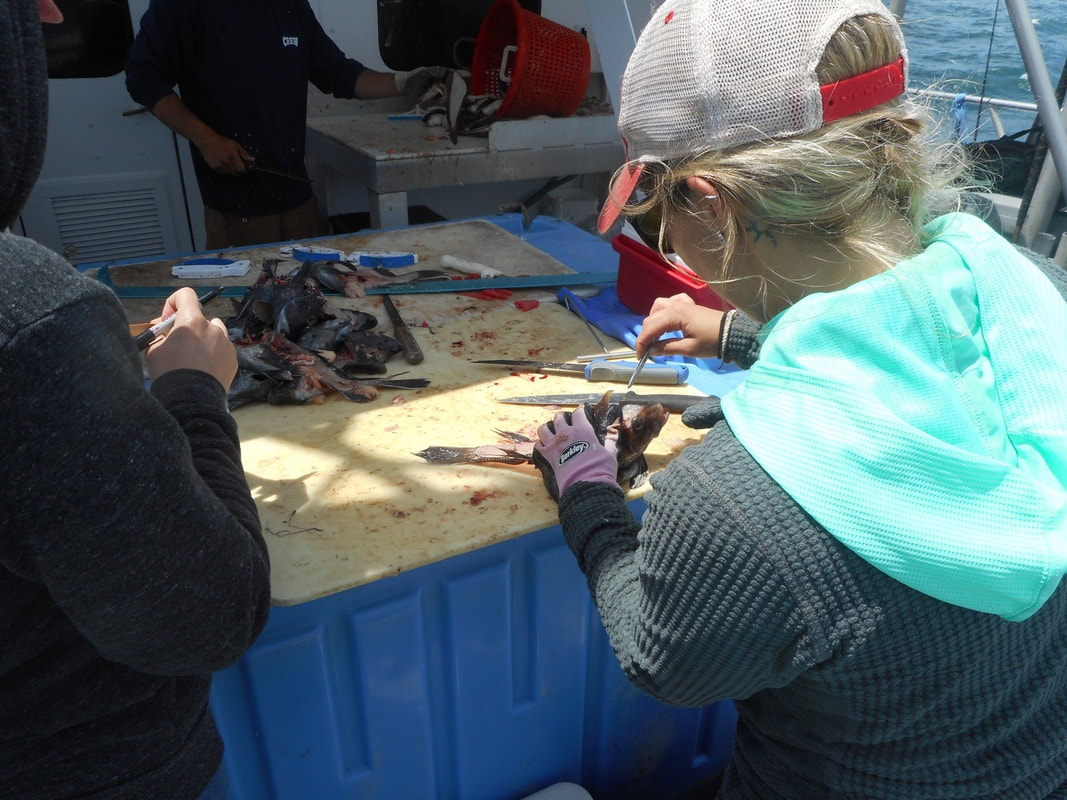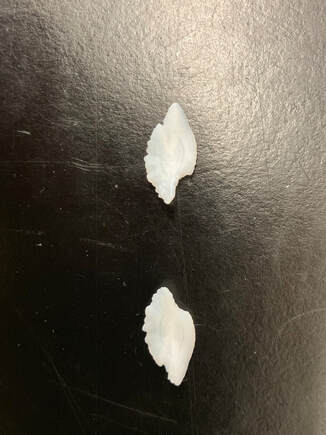CURRENT RESEARCH
Migration Impacts on Black Sea Bass Energetics and Reproductive Output
The entire range of the Northeastern stock of black sea bass spans from Cape Hatteras, NC to the Gulf of Maine. During the winter, black sea bass are found on the continental shelf edge off the coasts of Virginia, Maryland, and Delaware. But during the summer, these fish migrate inshore and distribute themselves throughout their entire range. It is during this time that black sea bass spawn. Because of this, black sea bass experience different physical dynamics (i.e. temperature) and migration distances during their spawning season.
I am investigating the effects of migration distance and temperature on the entire range of black sea bass by collecting black sea bass from Virginia, Delaware, New Jersey and Massachusetts pre-, during, and post-spawning. I am collecting energetics data including hepatosomatic index (liver/body weight), total lipid concentration, and percent dry weight of liver, muscle and gonad tissues. For reproductive output, I am collecting gonadosomatic indices (gonad weight/body weight).
I am investigating the effects of migration distance and temperature on the entire range of black sea bass by collecting black sea bass from Virginia, Delaware, New Jersey and Massachusetts pre-, during, and post-spawning. I am collecting energetics data including hepatosomatic index (liver/body weight), total lipid concentration, and percent dry weight of liver, muscle and gonad tissues. For reproductive output, I am collecting gonadosomatic indices (gonad weight/body weight).
Assessing the Use of Metabolic Index to Predict Distribution Shifts for Important US Northeast Shelf Fisheries Species
There is no question that ocean warming is affecting the populations of many of our important fisheries species along the US Northeast Shelf. The most prominent affect of ocean warming has been attributed to the shifting distribution fish species poleward and/or deeper in the water column. Recent effort to include the effects of ocean warming on fish distribution use ocean temperature as a predictor, or in other words, as a correlative term. However, using a metric measured in the laboratory that links temperature effects directly to changes in fish physiology instead of a correlative temperature term, would our models perform better?
For changes in the center of fish biomass over time, I am assessing the difference in predictive abilities of using correlative environmental terms such as temperature and oxygen to the performance of incorporating Metabolic Index, a species-specific measurement derived from laboratory studies. This will be done both at the seasonal and decadal scale. A big obstacle to overcome for this is limited laboratory measurements for fish and consistent measurements of dissolved oxygen in the past along the US Northeast shelf. Fine-scale resolution of modeled bottom dissolved oxygen is not yet available for this region.
For changes in the center of fish biomass over time, I am assessing the difference in predictive abilities of using correlative environmental terms such as temperature and oxygen to the performance of incorporating Metabolic Index, a species-specific measurement derived from laboratory studies. This will be done both at the seasonal and decadal scale. A big obstacle to overcome for this is limited laboratory measurements for fish and consistent measurements of dissolved oxygen in the past along the US Northeast shelf. Fine-scale resolution of modeled bottom dissolved oxygen is not yet available for this region.
Field Metabolic Rate and Thermal History Estimates of Black Sea Bass Using Stable Isotope Analysis on Otoliths
While I have been successful in measuring black sea bass metabolic rates in the laboratory, it is almost impossible to obtain accurate field metabolic rate measurements. The field metabolic rate includes metabolism needed for maintenance (standard metabolic rate) and the additional metabolism used for daily activities that include but not limited to swimming, foraging, digestion, and evading predators. What if we could estimate the field metabolic rate of black sea bass and compare this to the laboratory results?
Using otoliths, we are now able to back-calculate the field metabolic rate of a fish using carbon stable isotopes. The otolith is the calcium carbonate "inner ear bone" of fish that is used to feel gravity and movement. Each year another ring of calcium carbonate is laid down on the otolith which provides an age of the fish (just like tree rings). In addition, the fluid that the otolith rests in can contain signatures from the blood and be incorporated in the growth ring. It is here that we measure the carbon stable isotope and eventually obtain a field metabolic rate. We can also look at oxygen stable isotopes that can provide an estimate of temperature the fish was in. Because an otolith has a ring for each year of life, we can obtain an entire thermal history of the fish and see if those temperatures corroborate with where we expect to find the fish through modeling or laboratory studies.
I am collecting black sea bass in New Jersey, Delaware, and Virginia and removing otoliths and muscle tissue (to determine the dietary component of the carbon stable isotope signature). I am collaborating with Dr. Clive Trueman at the University of Southampton who will assist in the stable isotope analyses.
Using otoliths, we are now able to back-calculate the field metabolic rate of a fish using carbon stable isotopes. The otolith is the calcium carbonate "inner ear bone" of fish that is used to feel gravity and movement. Each year another ring of calcium carbonate is laid down on the otolith which provides an age of the fish (just like tree rings). In addition, the fluid that the otolith rests in can contain signatures from the blood and be incorporated in the growth ring. It is here that we measure the carbon stable isotope and eventually obtain a field metabolic rate. We can also look at oxygen stable isotopes that can provide an estimate of temperature the fish was in. Because an otolith has a ring for each year of life, we can obtain an entire thermal history of the fish and see if those temperatures corroborate with where we expect to find the fish through modeling or laboratory studies.
I am collecting black sea bass in New Jersey, Delaware, and Virginia and removing otoliths and muscle tissue (to determine the dietary component of the carbon stable isotope signature). I am collaborating with Dr. Clive Trueman at the University of Southampton who will assist in the stable isotope analyses.




